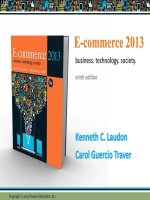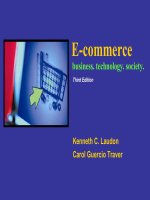Lecture E-commerce 2013: Business, technology, society (9/e): Chapter 12 - Kenneth C. Laudon, Carol Guercio Traver
Bạn đang xem bản rút gọn của tài liệu. Xem và tải ngay bản đầy đủ của tài liệu tại đây (1.85 MB, 56 trang )
E-commerce 2013
business. technology. society.
ninth edition
Kenneth C. Laudon
Carol Guercio Traver
Copyright © 2013 Pearson Education, Inc.
Chapter 12
B2B E-commerce: Supply Chain
Management and Collaborative
Commerce
Copyright © 2013 Pearson Education, Inc.
Volkswagen Builds Its B2B
Net Marketplace
Why didn’t Volkswagen want to use a more open or
public electronic exchange for its parts supply?
Why didn’t it join an industry consortium such as
Covisint?
What kinds of services are provided by
VWGroupSupply?
What is eCAP and who benefits from its use?
Do you think suppliers are disadvantaged by this
B2B marketplace?
Copyright © 2013 Pearson Education, Inc.
Slide 12-3
Trends in B2B E-commerce
Mitigation of global supply chain risks
Regional manufacturing
Flexibility
Cost of using B2B systems has fallen, allowing
smaller firms to participate
Big data
Growing emphasis of business analytics
Sustainable supply chains
B2B firms using social networking platforms
Growing use of mobile platform
Copyright © 2013 Pearson Education, Inc.
Slide 12-4
Defining B2B Commerce
Before Internet:
B2B transactions called trade or procurement process
Total inter-firm trade:
Total flow of value among firms
B2B commerce:
All types of computer-enabled inter-firm trade
B2B e-commerce:
The portion of B2B commerce enabled by the Internet
Copyright © 2013 Pearson Education, Inc.
Slide 12-5
The Evolution of B2B Commerce
Automated order-entry systems
Seller-side solution
Electronic data interchange (EDI)
Buyer-side solution
Hub-and-spoke
system
Serve vertical markets
B2B electronic storefronts
Net marketplaces
Private industrial networks
Copyright © 2013 Pearson Education, Inc.
Slide 12-6
Evolution of the Use of
Technology Platforms in B2B Commerce
Figure 12.1, Page 762
Copyright © 2013 Pearson Education, Inc.
Slide 12-7
The Growth of B2B E-commerce
2012–2016: B2B e-commerce will grow
from 40 to 42% of total inter-firm trade
Private industrial networks continue to
play dominant role in B2B
Non-EDI B2B e-commerce most rapidly
growing type of e-commerce
EDI still large but will decline over time
Copyright © 2013 Pearson Education, Inc.
Slide 12-8
Growth of B2B Commerce 2000–2016
Figure 12.2, Page 765
Copyright © 2013 Pearson Education, Inc.
SOURCES: Based on data from U.S. Census Bureau, 2012a; authors’ estimates.
Slide 12-9
Industry Forecasts
Not all industries similarly affected by B2B
e-commerce
Not all industries would benefit equally
Factors influencing move to e-commerce
Significant utilization of EDI
Large investments in IT and Internet infrastructure
e.g., aerospace and defense, computer
Market concentrated on purchasing
or selling
e.g., energy, chemical industries
Copyright © 2013 Pearson Education, Inc.
Slide 12-10
Potential Benefits of B2B E-commerce
Lower administrative costs
Lower search costs for buyers
Reduced inventory costs
Increasing competition among suppliers
Reducing inventory carried
Lower transaction costs:
Automation, eliminating paperwork
Increased production flexibility by ensuring
just-in-time parts delivery
Copyright © 2013 Pearson Education, Inc.
Slide 12-11
Potential Benefits (cont.)
Improved quality of products by increasing
cooperation among buyers and sellers
Decreased product cycle time
Increased opportunities for collaboration
Greater price transparency
Increased visibility, real-time information
sharing
However, some risk is posed by increased
globalization and consolidation
Copyright © 2013 Pearson Education, Inc.
Slide 12-12
Insight on Society: Class Discussion
Where’s My iPad: Supply Chain
Risk and Vulnerability
Why does concentrating production on
fewer suppliers also concentrate risk?
How does globalization play a part in
increased risk?
What types of procedures could be
implemented, given increased
globalization, to reduce risk?
Copyright © 2013 Pearson Education, Inc.
Slide 12-13
The Procurement Process and
the Supply Chain
Procurement process:
The way firms purchase materials they need to make
products
Supply chain:
Firms that purchase goods, their suppliers, and their
suppliers’ suppliers, relationships and processes
involved
Steps in procurement process
Deciding who to buy from and what to pay
Completing transaction
Copyright © 2013 Pearson Education, Inc.
Slide 12-14
The Procurement Process
Figure 12.3, Page 769
Copyright © 2013 Pearson Education, Inc.
Slide 12-15
Types of Procurement
Firms purchase two types of goods
Direct goods: Integrally involved in production process
Indirect goods: All goods not directly involved in
production process (MRO goods)
Firms use two methods to purchase
Contract purchasing:
Involves long-term written agreements to purchase specified
products, with agreed-upon terms and quality
Spot purchasing:
Involves purchase of goods based on immediate needs in larger
marketplaces that involve many suppliers
Copyright © 2013 Pearson Education, Inc.
Slide 12-16
Types of Procurement (cont.)
Procurement is highly information
intensive and labor intensive
Requires managing information among many
corporate systems
Involves 1.2 million U.S. workers
Multi-tier supply chain
Complex series of transactions between firm
and thousands of suppliers, supplying
thousands of goods
Copyright © 2013 Pearson Education, Inc.
Slide 12-17
The Multi-tier Supply Chain
Figure 12.4, Page 771
Copyright © 2013 Pearson Education, Inc.
Slide 12-18
The Role of Existing Legacy
Computer Systems
Legacy computer systems
Generally, older mainframe and minicomputer systems
used to manage key business processes within firm
Enterprise systems
Corporate-wide
Support/control
all aspects of production, including
Procurement
Finance
Human resources
Copyright © 2013 Pearson Education, Inc.
Slide 12-19
Trends in Supply Chain Management
Supply chain management (SCM)
Activities used to coordinate key players in the procurement
process
Major developments in SCM
Just-in-time and lean production
Supply chain simplification
Adaptive supply chains
Accountable supply chains
Sustainable supply chains
Electronic data interchange
Supply chain management systems
Collaborative commerce
Copyright © 2013 Pearson Education, Inc.
Slide 12-20
Just-in-Time and Lean Production
Just-in-Time production
Method of inventory cost management
Seeks to eliminate excess inventory to bare
minimum
Lean production
Set of production methods and tools
Focuses on elimination of waste throughout
customer value chain, not just inventory
Copyright © 2013 Pearson Education, Inc.
Slide 12-21
Supply Chain Simplification
Reducing size of supply chain
Working with strategic group of suppliers to reduce
product and administrative costs and improving
quality
Essential for just-in-time production models
May involve:
Joint product development and design
Integration of computer systems
Tight coupling
Ensuring precise delivery of ordered parts at specific times
Copyright © 2013 Pearson Education, Inc.
Slide 12-22
Adaptive Supply Chains
Reducing centralization
Reduce risks caused by relying on single
suppliers who are subject to local instability
e.g., European financial crisis, Japanese earthquake
Creating regional or product-based
supply chains
Allowing production to be moved to temporary
safe harbors in case of local manufacturing
disruptions
Copyright © 2013 Pearson Education, Inc.
Slide 12-23
Accountable Supply Chains
Labor conditions in low-wage, underdeveloped producer countries are acceptable
to consumers
Slave/forced labor
Child labor
Routine exposure to toxic substances
More than 48 hrs/week
Harassment and abuse
Sexual exploitation
Adequate compensation
Copyright © 2013 Pearson Education, Inc.
Slide 12-24
Sustainable Supply Chains
Taking social and ecological interests
into account
e.g., water usage, air pollution
Using most efficient environment—
regarding means of production,
distribution, logistics
Good business, over long-term
Create value for consumers, investors,
communities
Copyright © 2013 Pearson Education, Inc.
Slide 12-25









